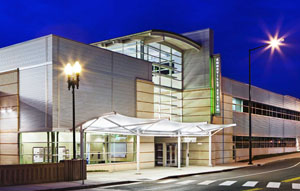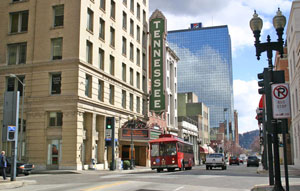Knoxville's Central City Reports Many Success Stories from Past Decade

MPC staff has embarked on the process of updating the Central City Sector Plan, adopted in 2003. Planners Mike Carberry and Jeff Archer and UT work-study volunteer Eric Matravers are preparing a background report on existing conditions in the sector to kick-off the project. In the nine years since the Central City Sector Plan was adopted, significant accomplishments in neighborhood conservation, economic development, corridor revitalization, and urban design can be linked to the planning efforts of MPC and several partner agencies. A few of those successes are profiled here.
Considerable business revitalization has occurred in the I-275 corridor, as a result of both public planning initiatives and visionary private investment. Public planning led the way to a redevelopment area being established and a business access road parallel to I-275 being approved. Sysco's reuse of the former Coster rail yards and Holston Gases' redevelopment of the long-vacant Brookside Mills property marked significant private-sector investment in the area.
Closer in, Downtown North has seen several measures to revitalize an area extending from the Old City and outward along North Central Street. Knoxville's Community Development Corporation (KCDC) and the City of Knoxville created a redevelopment district, allowing improvements via tax increment financing. As a result, over 20 businesses completed storefront (facade) renovations. Additional infrastructure investments included road and sidewalk improvements now underway from Happy Holler to downtown.

Entertainment opportunities abound: the list includes the new Regal Riviera theaters, a restored Tennessee Theatre, the East Tennessee History Center, the Square Room, and other private venues. Public facility investments include Knoxville Area Transit's new Knoxville Station Transit Center, Market Square renovations, a new parking garage, and the reuse of the L&N Station as the STEM Academy for Knox County Schools. 
Access to downtown was greatly enhanced with the Tennessee Department of Transportation's Smart Fix 40 program, bringing improvements to I-40, James White Parkway, and Hall of Fame Boulevard.
Moving eastward, the Magnolia corridor accomplishments include the adoption of an area plan, followed soon after by the creation of a redevelopment area that includes the warehouse district east of the Old City, extending to Bertrand Street.
On the west side, the adoption of a Cumberland Avenue corridor plan to guide street redesign will result in a more pedestrian-friendly thoroughfare with wider sidewalks and a greater mix of land uses. The adoption of a new form-based zoning code for the area is anticipated this year. Street improvements are slated to begin in 2013.
After seeing incompatible uses among its community of early-20th century houses, Lonsdale and Oakwood?Lincoln Park residents asked local planners and officials to implement infill housing overlay zoning. The overlay requires design review for construction and renovation, resulting in new investment that is compatible with existing structures throughout the area. Dozens of new houses have been completed under this program.
The Lonsdale community has a significant track record of offering affordable housing, and City of Knoxville officials have sought residential zoning for long-vacant industrial and commercial property. Also, a redevelopment district was created for the Lonsdale community, the new retail center at the I-275/Heiskell Avenue interchange an early result.
KCDC's public housing renovation and redevelopment efforts have netted several noteworthy gains, including restoration of Lonsdale Homes and North Ridge Homes. Planning for redevelopment of Western Heights and Walter P. Taylor Homes is underway. In Mechanicsville Commons, housing, office, and retail projects are virtually built-out, and the renovation of Eastport School and creation of senior housing there are additional community success stories.
Park and related improvements throughout the Central City Sector over the past few years have included the second phase of Caswell Park and the Cansler YMCA, the Downtown Dog Park, Krutch Park improvements, Second Creek Greenway development, and a renovated Lonsdale Park and Recreation Center.
MPC planners are optimistic that growth and reinvestment momentum in the Central City Sector will be sustained with updates to the plan. Staff efforts will rely on community involvement in the planning process and MPC will be holding public meetings toward that end in late spring.
Posted 2-29-2012, written by Mike Carberry

